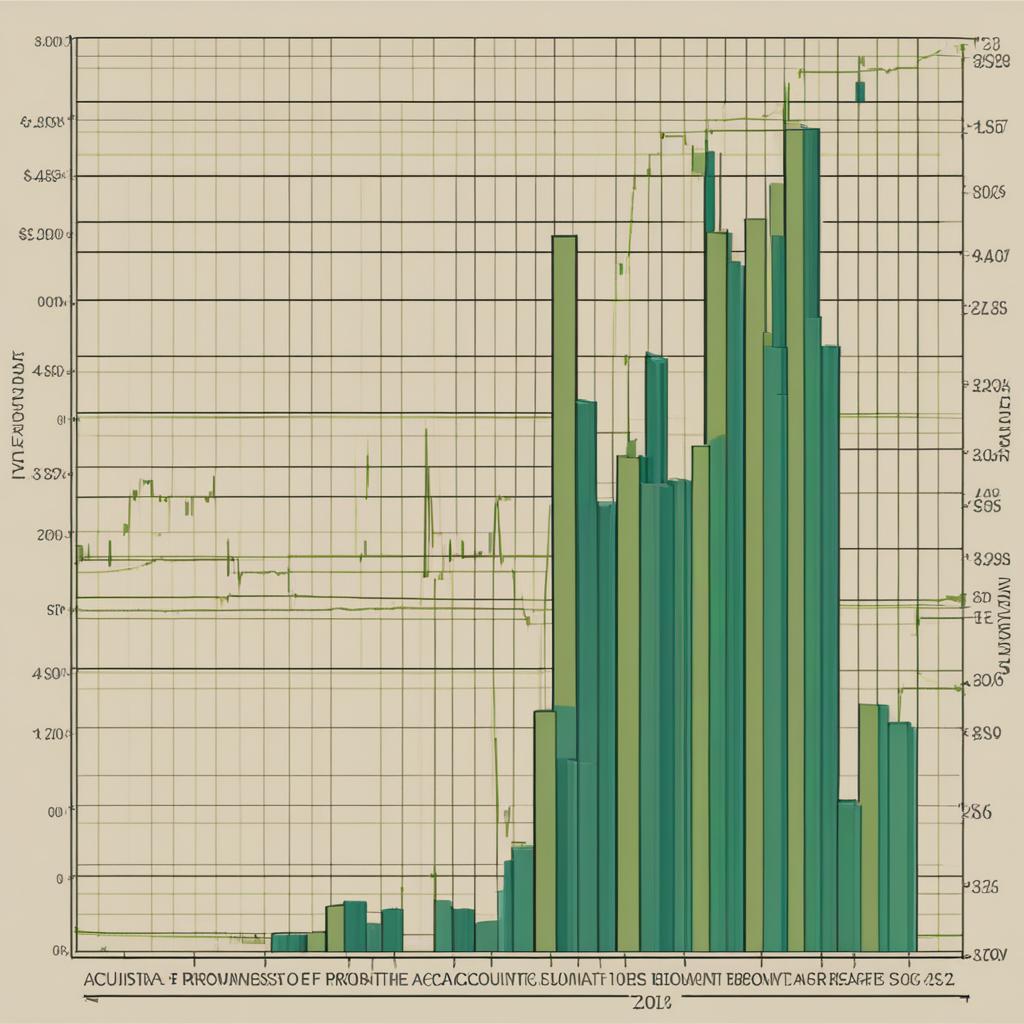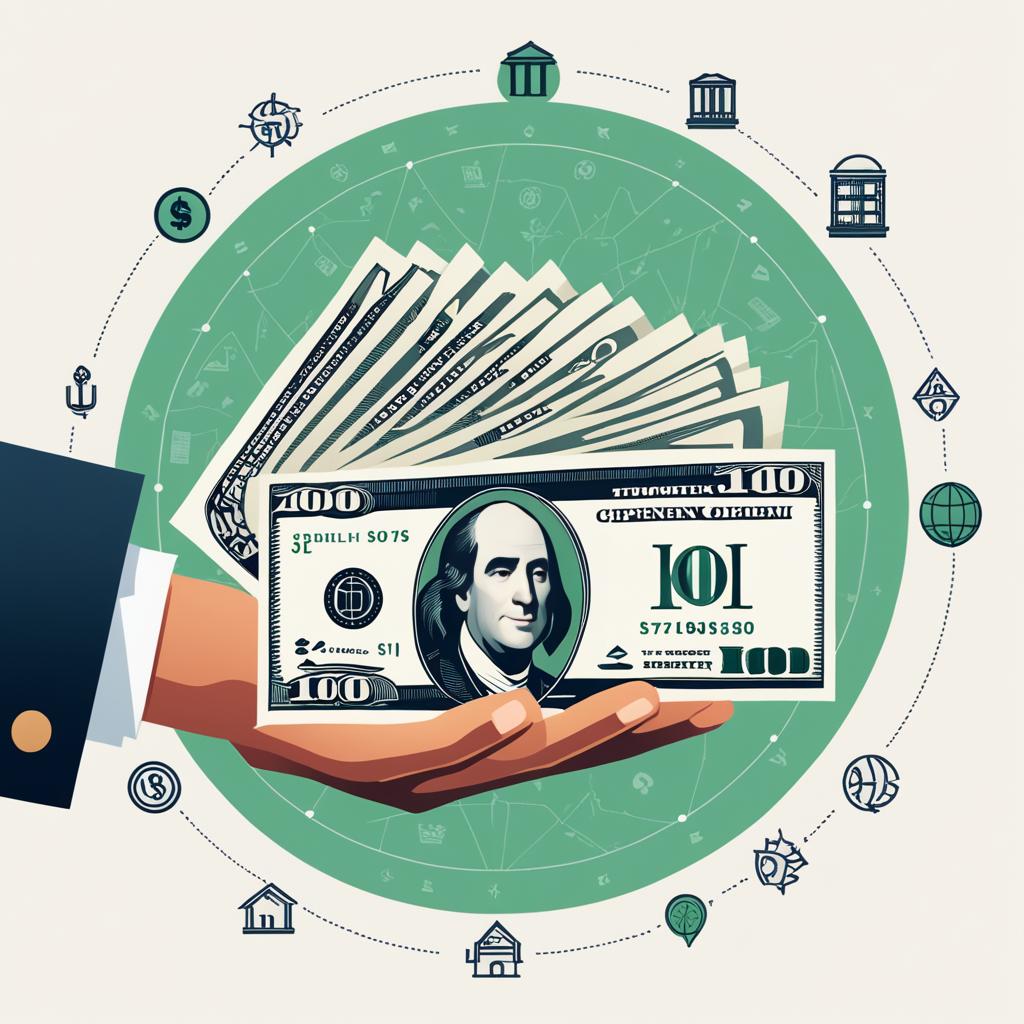Building long-term wealth doesn’t require a large sum of money. In fact, you can start investing with just $100 or less. This article will guide you through 11 ways to invest $100 and build wealth over time. Learn how to create a portfolio, trade fractional shares, earn interest with a high-yield savings account, start an emergency fund, save for a child’s education, open a brokerage account or robo-advisor account, consolidate and pay off debt, start a retirement account, explore peer-to-peer lending, and consider cryptocurrency. The article also provides an investment calculator to estimate how long it will take to reach six figures when consistently contributing $100 each month.
Key Takeaways:
- Investing with $100 is possible and can lead to long-term wealth accumulation.
- Consider building a diverse investment portfolio to mitigate risks and maximize returns.
- Trading fractional shares allows you to invest in high-priced stocks without needing to purchase a full share.
- Open a high-yield savings account to earn interest and grow your $100 investment.
- Starting an emergency fund can provide financial security and protect you from unexpected expenses.
Building a Portfolio
Building a diverse investment portfolio is essential for long-term wealth growth. With $100, you have various options to create a well-rounded portfolio that aligns with your financial goals. Let’s explore some key strategies to consider:
1. Fractional Shares
Investing in fractional shares allows you to acquire a portion of a stock rather than a full share. This approach enables you to diversify your investments across multiple companies, even with limited funds. With $100, you can access fractional shares and build a well-diversified stock portfolio.
2. Exchange-Traded Funds (ETFs)
ETFs are investment vehicles that track specific indexes, sectors, or industries. By investing in ETFs, you can gain exposure to a variety of stocks within a specific category. For example, if you believe in the growth potential of the information technology sector, you can allocate a portion of your $100 towards an ETF that tracks this sector.
3. Bonds
Bonds offer a reliable investment option with lower risk compared to stocks. Investing in bonds provides a steady return on investment (ROI) and helps balance the overall risk profile of your portfolio. With $100, you can consider investing in government bonds or corporate bonds, depending on your risk tolerance and investment objectives.
In order to build a diversified portfolio, it’s important to allocate your $100 across different asset classes. This helps protect your investments from volatility and ensures a balanced approach to wealth creation.
Here’s a breakdown of how you might allocate your $100 to build a diversified portfolio:
| Asset Class | Allocation |
|---|---|
| Fractional Shares (Stocks) | $45 |
| Exchange-Traded Funds (ETFs) | $30 |
| Bonds | $25 |
By following this allocation, you can benefit from the growth potential of stocks, the diversification provided by ETFs, and the stability of bonds to create a well-rounded portfolio.
Remember, building a portfolio is a continuous process. As you invest more over time, you can adjust your allocation and explore additional investment opportunities.
Trading Fractional Shares
When it comes to investing with small amounts of money, trading fractional shares is a game-changer. It allows you to tap into the world of high-priced stocks without breaking the bank. With as little as $1, you can invest in your favorite companies and diversify your portfolio like a seasoned investor.
Micro-investing apps such as Stash, Robinhood, and Public have made trading fractional shares accessible to everyone. These user-friendly investment apps enable you to purchase fractional shares of stocks and exchange-traded funds (ETFs) effortlessly. You no longer need to buy a full share, making it possible to invest with small amounts of money.
Trading fractional shares has several advantages for those looking to get started with investing. Firstly, it opens up a wide range of investment opportunities. You have the ability to invest in stocks like Amazon, Google, or Tesla, which may have high share prices. By purchasing fractional shares, you can own a piece of these companies without needing a substantial amount of capital.
“Investing in fractional shares allows me to diversify my portfolio without breaking the bank. I can invest in different sectors and companies that I believe in, even if they have high share prices.”
Furthermore, fractional share investing is a great option for beginners. It eliminates the barrier of high share prices and allows you to dip your toes into the investing world with small amounts of money. It’s an excellent way to learn about investing and experience the ups and downs of the stock market.
With trading fractional shares, you have the opportunity to build a well-diversified portfolio tailored to your risk tolerance and investment goals. You can invest in companies across various industries and sectors, spreading your risk and increasing the potential for long-term growth.
So, whether you’re interested in tech stocks, healthcare companies, or renewable energy, trading fractional shares gives you the flexibility to invest in the industries you believe in.
Investment Apps for Trading Fractional Shares
If you’re ready to start trading fractional shares, here are some popular micro-investing apps to consider:
- Stash: Stash offers a user-friendly platform that allows you to invest in fractional shares, as well as exchange-traded funds (ETFs) and bonds.
- Robinhood: Known for its commission-free trades, Robinhood is a popular choice for trading fractional shares of stocks and ETFs.
- Public: Public is a social investing app that focuses on fractional shares and community-driven investing.
These investment apps provide an intuitive and convenient way to start your investment journey with small amounts of money. They offer educational resources, easy-to-use interfaces, and the ability to automate your investments.
Trading Fractional Shares: A Step Towards Wealth Building
Trading fractional shares is an exciting opportunity for investors looking to start with small amounts of money. It democratizes investing, making it accessible to everyone, regardless of their financial situation.
By utilizing micro-investing apps and trading fractional shares, you can begin your investment journey and start building wealth over time. Take advantage of the convenience and flexibility offered by these platforms, and watch your portfolio grow, one fraction at a time.

High-Yield Savings Accounts
If you’re looking to make the most of your $100 investment, consider opening a high-yield savings account. These accounts, offered by online banks, provide higher interest rates compared to traditional banks, allowing your money to grow with compound interest.
Unlike regular savings accounts, high-yield savings accounts offer competitive interest rates that can help your money work harder for you. The interest earned on your deposit is compounded over time, which means your savings have the potential to grow faster.
To find the best high-yield savings account for your $100, take the time to compare different online banks and their rates. Look for banks that offer attractive interest rates and account features that align with your financial goals. Keep in mind that interest rates can fluctuate, so it’s important to monitor your account and make adjustments as necessary.
Additionally, consider making monthly contributions to your high-yield savings account to maximize your investment. By consistently adding to your savings, you can take advantage of the power of compound interest and accelerate the growth of your $100.
Starting an Emergency Fund
When it comes to financial security, having an emergency fund is crucial. By investing $100 in an emergency fund, you can protect yourself from unexpected financial setbacks. Consider opening either a money market account or a high-yield savings account to store your emergency funds.
Money market accounts are a reliable option, offering higher interest rates compared to regular savings accounts. These accounts may also come with checking features, making it easier for you to access your funds whenever needed. On the other hand, high-yield savings accounts are another excellent choice. They offer competitive interest rates and allow your money to grow with compound interest over time.
Building an emergency fund should be a priority, as it provides a safety net during challenging times. Financial experts recommend having at least three to six months’ worth of expenses saved. This can cover unexpected medical bills, car repairs, or any other emergencies that may arise.

Having an emergency fund in place not only offers peace of mind but also helps you avoid going into debt when unexpected expenses occur. It acts as a financial cushion, giving you the confidence to face any unforeseen circumstances that may arise in life.
Benefits of a Money Market Account
A money market account offers several advantages for storing your emergency funds:
- Higher interest rates compared to regular savings accounts.
- Check-writing capabilities for easier access to your funds.
- Federal insurance up to $250,000, providing additional security.
- Ability to link the account to your checking account for convenient transfers.
Benefits of a High-Yield Savings Account
A high-yield savings account provides the following benefits for your emergency fund:
- Competitive interest rates that allow your money to grow faster.
- Compound interest, which means you earn interest on your initial deposit and the interest it accrues over time.
- Convenience of online banking, making it easy to manage your funds.
- Access to customer support and account management services.
| Account Type | Interest Rate | Minimum Deposit | Additional Features |
|---|---|---|---|
| Money Market Account | 1.75% | $500 | Check-writing capabilities |
| High-Yield Savings Account | 2.15% | $100 | Online banking, compound interest |
Robo-Advisor Accounts
When it comes to investing with $100, robo-advisor accounts are an excellent choice. Platforms like Betterment or Acorns offer automated investing and professional portfolio management, making it easier for small investors to diversify their investments and maximize their returns.
Robo-advisors use sophisticated algorithms to create customized portfolios based on your risk tolerance and financial goals. This automated approach takes the guesswork out of investing and ensures that your money is working efficiently for you.
One of the key benefits of robo-advisor accounts is the low initial investment requirement. Unlike traditional investment options that may require thousands of dollars to get started, robo-advisors allow you to start investing with as little as $100. This makes it accessible for anyone looking to grow their wealth.
Robo-advisors also offer features like automatic rebalancing and dividend reinvestment. This means that your portfolio will be regularly adjusted to maintain the desired asset allocation and any dividends earned will be reinvested automatically. These features help optimize your portfolio’s performance over time.
Another advantage of robo-advisor accounts is the low fees involved. Traditional investment options often come with high management fees, eating into your potential returns. Robo-advisors, on the other hand, offer transparent and competitive fee structures, ensuring that a larger portion of your money goes towards your investments.
Overall, robo-advisor accounts provide a convenient and cost-effective way to enter the world of investing with $100. With their automated approach to portfolio management and low initial investment requirement, they are an ideal option for small investors looking to grow their wealth.

Benefits of Robo-Advisor Accounts:
- Automated investing and portfolio management
- Customized portfolios based on risk tolerance and financial goals
- Low initial investment requirement
- Automatic rebalancing and dividend reinvestment
- Transparent and competitive fee structures
“Robo-advisor accounts offer a convenient and cost-effective way to start investing with $100.”
Investing in a Brokerage Account
When it comes to growing your $100 investment, a brokerage account is a powerful tool that allows you to buy individual stocks and participate in the stock market’s potential. With commission-free trades offered by apps like TD Ameritrade and M1 Finance, low-cost trading has become accessible even to small investors.
However, it’s important to remember that the stock market can be volatile, and finding success requires careful research and consideration. Before investing, take the time to understand the companies you’re interested in and ensure they align with your long-term investment goals.
Diversification is also key to mitigating risk and maximizing potential returns. By spreading your investment across different stocks and industries, you’ll be better positioned to weather market fluctuations and take advantage of various growth opportunities.
| Advantages of Investing in a Brokerage Account | Considerations |
|---|---|
|
|
By investing in a brokerage account and carefully selecting individual stocks, you can navigate the stock market and work towards growing your initial $100 investment. Just remember to stay informed, diversify your portfolio, and be prepared for potential market fluctuations along the way.

Retirement Accounts
Starting a retirement account with $100 is a smart long-term investment strategy that can provide significant benefits for your future. There are different options available to begin securing your retirement, including employer-sponsored plans like a 401(k) or individual retirement accounts (IRA).
401(k) or Other Employer-Sponsored Plans
If your employer offers a 401(k) or other retirement plan, take advantage of the opportunity to participate. These plans typically allow you to contribute a percentage of your salary pre-tax, helping to lower your taxable income while saving for retirement.
An employer-sponsored plan may also offer matching contributions, where your employer matches a portion of your contributions. This is essentially free money that can significantly boost your retirement savings. For example, if your employer offers a 3% match on a 401(k) account and you contribute $100 per month, your employer will contribute an additional $3 each month, effectively increasing your savings.
Individual Retirement Account (IRA)
If you don’t have access to an employer-sponsored plan or want to augment your retirement savings further, consider opening an individual retirement account (IRA). There are two main types of IRAs: Traditional IRAs and Roth IRAs.
- Traditional IRAs: With a Traditional IRA, your contributions may be tax-deductible, meaning you can deduct the amount you contribute from your annual taxable income. This provides an immediate tax benefit and allows your investments to grow tax-deferred until you make withdrawals in retirement.
- Roth IRAs: In contrast, Roth IRAs offer tax-free withdrawals in retirement. While your contributions are not tax-deductible, your investments can grow tax-free. This means you won’t owe taxes on the growth of your investments when you withdraw funds in retirement.
Both Traditional and Roth IRAs have contribution limits and eligibility criteria, so it’s essential to familiarize yourself with the respective rules and regulations of each type before opening an account.
| Retirement Account Option | Tax Benefits | Withdrawals |
|---|---|---|
| 401(k) or Other Employer-Sponsored Plans | Contributions may be pre-tax | Taxed upon withdrawal in retirement |
| Traditional IRA | Contributions may be tax-deductible | Taxed upon withdrawal in retirement |
| Roth IRA | Contributions are not tax-deductible | Tax-free withdrawals in retirement |
By investing $100 into a retirement account, you’re taking a crucial step towards securing your financial future. Whether through employer-sponsored plans or opening an IRA, these accounts provide a vehicle for your investments to grow tax-free over time, helping you build a substantial retirement nest egg.
Peer-to-Peer Lending
When it comes to diversifying your investment portfolio, peer-to-peer lending platforms offer an intriguing opportunity. These platforms, such as LendingClub, connect borrowers with lenders, allowing individuals to invest in personal loans and earn interest. With as little as $25, you can participate in multiple loans, spreading your investment and minimizing risk.
While there is a potential risk of default, peer-to-peer lending can yield higher returns compared to traditional bank investments. By cutting out the middleman, investors have the chance to earn substantial interest rates on their investments.
To get started with peer-to-peer lending, sign up with a reputable platform like LendingClub. Once you’ve created an account, you can browse various loan requests, assessing the borrower’s profile and creditworthiness. Consider diversifying your investments across different loan types, durations, and risk levels to further mitigate any potential losses.
The Benefits of Peer-to-Peer Lending
Investing in peer-to-peer lending offers several advantages:
- Diversification: Peer-to-peer lending allows you to diversify your portfolio by investing in a wide range of loans. This diversification helps to spread risk and increase the potential for returns.
- Higher Returns: Compared to traditional bank investments, peer-to-peer lending typically offers higher interest rates. This increased return potential makes it an attractive option for investors looking to grow their wealth.
- Flexibility: Peer-to-peer lending platforms provide you with the flexibility to choose loans that align with your risk tolerance and financial goals. You can select loans based on factors such as credit score, loan purpose, and duration.
It’s important to note that peer-to-peer lending is not without risks. Borrowers may default on their loans, which could result in a loss of investment capital. Additionally, the lack of government-backed guarantees means that peer-to-peer lending is not as secure as traditional bank investments.
If you decide to explore peer-to-peer lending, ensure you carefully assess each loan opportunity and diversify your investments to mitigate risk.
| Pros | Cons |
|---|---|
| – Higher interest rates compared to traditional bank investments | – Risk of default and loss of investment capital |
| – Diversification through investing in multiple loans | – Lack of government-backed guarantees |
| – Flexibility to choose loans based on risk tolerance and financial goals |
While peer-to-peer lending can be a rewarding investment strategy, it’s crucial to conduct thorough research and carefully consider the risks involved. Start by allocating a portion of your investment portfolio to peer-to-peer lending and gradually increase your investments as you become more comfortable with the platform and its potential returns.
Consolidating and Paying Off Debt
If you have significant debt, it’s crucial to take steps towards paying it off and achieving financial freedom. By consolidating your debts and focusing on high-interest balances, you can save money on interest payments and accelerate your journey towards debt-free living.
One effective strategy is to consolidate your debts into a lower interest loan or credit card with a 0% introductory APR. This can provide immediate relief by reducing the amount of interest you’re paying each month. By consolidating, you streamline your payments and simplify your financial obligations.
Consolidation allows you to combine multiple debts, such as credit card balances, personal loans, or medical bills, into a single loan or credit card. This not only makes it easier to manage your finances but also helps you save on interest payments. With a lower interest rate, more of your monthly payments go towards reducing your debt principal, allowing you to pay off your debt faster.
Take advantage of this opportunity to create a solid plan for paying off your debt. Set a budget, allocate a portion of your income towards debt repayment, and stick to the plan. Consider making extra payments whenever possible, even if it’s just a small amount. Every bit helps to chip away at your debt and move closer to financial freedom.
| Benefits of Debt Consolidation | Considerations for Debt Consolidation |
|---|---|
|
|
By consolidating your debt, you’re taking a proactive step towards regaining control of your finances. You’ll save money on interest, simplify your repayment process, and make significant progress towards becoming debt-free. Remember, financial freedom is within reach, and with determination and careful planning, you can achieve it.
Quote:
“Consolidating your debts into a lower interest loan or credit card can provide immediate relief and save you money on interest payments.”\n
– Personal Finance Expert
Keep in mind that debt consolidation is not a one-size-fits-all solution. It’s essential to evaluate your financial situation, consult with a financial advisor if needed, and choose the best option for your needs. With a clear plan, discipline, and perseverance, you can successfully eliminate debt and experience the freedom of improved financial well-being.
Considering Cryptocurrency
Investing in cryptocurrency can be an enticing option for those intrigued by the potential of emerging technologies. With just $100, you can enter the world of digital assets and invest in popular cryptocurrencies like Bitcoin or Ethereum. However, it’s essential to approach this investment avenue with caution and thorough research.
The crypto market is known for its volatility, meaning the value of cryptocurrencies can fluctuate significantly within short periods. Understanding the risks associated with this market is crucial before making any investment decisions.
To get started, take the time to familiarize yourself with blockchain technology. This underlying technology is the backbone of cryptocurrencies and plays a vital role in their security and functionality.
There are numerous cryptocurrencies available, each with its own features and potential. Make sure to explore and educate yourself on the different options beyond Bitcoin and Ethereum. Diversifying your investments within the cryptocurrency space can help mitigate risks and potentially improve your returns.
“Investing in cryptocurrency is like riding a rollercoaster. It can be thrilling and rewarding, but it’s important to buckle up and be prepared for the twists and turns.” – Crypto Enthusiast
It’s essential to monitor the crypto market closely and stay updated on the latest trends and developments. This will help you make informed decisions based on market conditions.
Why Consider Cryptocurrency?
- Potential for High Returns: Cryptocurrencies have gained significant attention for their potential to deliver substantial returns, making them an attractive investment option.
- Access to a Global Market: Unlike traditional financial markets, the cryptocurrency market operates 24/7, allowing investors to trade at any time and tap into a global investing community.
- Disruptive Innovation: Cryptocurrencies and blockchain technology have the potential to disrupt various industries, including finance, supply chain management, and more. Investing in cryptocurrency allows you to be part of this technological revolution.
- Inflation Hedge: Some cryptocurrencies, like Bitcoin, are designed to have a limited supply, providing a potential hedge against inflation and preserving the value of your investment in the long run.
While investing in cryptocurrency can be exciting, it’s crucial to approach it with a clear strategy and risk management in mind. Only invest what you can afford to lose and consider consulting with a financial advisor if you’re unsure about navigating the crypto market.
Conclusion
Investing with $100 is an excellent way to start building long-term wealth. By employing the investment strategies discussed in this article, you can make your money work for you and create a solid foundation for future financial success.
One of the key strategies is building a diversified portfolio. By investing in fractional shares, exchange-traded funds (ETFs), and bonds, you can spread your investments across different asset classes and minimize risk. Additionally, consider opening a high-yield savings account or a robo-advisor account to earn interest and benefit from professional portfolio management.
It’s crucial to research and understand different investment options, align them with your financial goals, and diversify your investments. By doing so, you can maximize the potential returns while managing risk. Over time, even a modest investment of $100 can grow, contributing to your overall wealth-building journey.
Remember, wealth building is a long-term process, and success requires patience, discipline, and ongoing evaluation of your investment strategy. So take the time to educate yourself, stay informed about market trends, and adjust your portfolio accordingly. With dedication and the right investment strategies, you can thrive in the world of investing with $100 and pave the way for a prosperous financial future.
FAQ
How can I invest 0?
There are several ways to invest 0, such as building a diversified portfolio, trading fractional shares, opening a high-yield savings account, starting an emergency fund, exploring retirement accounts, and considering peer-to-peer lending or cryptocurrency.
How can I build a portfolio with 0?
With 0, you can invest in fractional shares, exchange-traded funds (ETFs), and bonds to create a diversified portfolio that spreads your investments across different asset classes.
Can I trade fractional shares with a small investment?
Yes, apps like Stash, Robinhood, and Public allow you to buy fractional shares for as little as
FAQ
How can I invest $100?
There are several ways to invest $100, such as building a diversified portfolio, trading fractional shares, opening a high-yield savings account, starting an emergency fund, exploring retirement accounts, and considering peer-to-peer lending or cryptocurrency.
How can I build a portfolio with $100?
With $100, you can invest in fractional shares, exchange-traded funds (ETFs), and bonds to create a diversified portfolio that spreads your investments across different asset classes.
Can I trade fractional shares with a small investment?
Yes, apps like Stash, Robinhood, and Public allow you to buy fractional shares for as little as $1, making it accessible for small investors to invest in high-priced stocks.
What are high-yield savings accounts?
High-yield savings accounts are online banking accounts that offer higher interest rates compared to traditional banks, allowing your money to grow with compound interest.
Should I start an emergency fund with $100?
Yes, investing $100 in an emergency fund is a wise decision. Consider opening a money market account or a high-yield savings account to store your emergency funds and protect yourself from unexpected financial setbacks.
What are robo-advisor accounts?
Robo-advisor accounts, like Betterment or Acorns, provide automated investing and professional portfolio management. These platforms create customized portfolios based on your risk tolerance and financial goals, making them accessible for investors with a small initial investment.
How can I invest in a brokerage account with $100?
Apps like TD Ameritrade and M1 Finance offer commission-free trades, making it affordable for small investors to buy individual stocks and take advantage of the stock market’s potential.
Should I start a retirement account with $100?
Yes, starting a retirement account with $100 is a smart long-term investment strategy. If your employer offers a 401(k) or other retirement plan, participate and take advantage of any employer matching contributions. If not, consider opening an individual retirement account (IRA) and making regular contributions.
What is peer-to-peer lending?
Peer-to-peer lending platforms, like LendingClub, allow investors to invest in personal loans and earn interest. Investing as little as $25 in multiple loans can diversify your investment and potentially earn higher returns compared to traditional bank investments.
Is debt consolidation a good use of $100?
If you have significant debt, using your $100 to consolidate and pay off high-interest debts can be a smart move. It can save you money on interest payments and help you pay off your debt faster, improving your overall financial well-being.
Is investing in cryptocurrency a good option with $100?
Investing $100 in cryptocurrency is a high-risk, high-reward option. It’s important to research and understand the volatility and risks associated with the crypto market before considering it as an investment option.
How can I grow my $100 investment over time?
By utilizing the strategies outlined in this article, such as building a portfolio, trading fractional shares, opening a high-yield savings account, starting an emergency fund, and exploring retirement accounts, you can make your $100 investment work for you and build long-term wealth.
How long will it take to reach six figures by contributing $100 per month?
You can use an investment calculator to estimate how long it will take to reach six figures by consistently contributing $100 each month. Factors such as the return on investment and compounding interest will determine the exact time frame.
, making it accessible for small investors to invest in high-priced stocks.
What are high-yield savings accounts?
High-yield savings accounts are online banking accounts that offer higher interest rates compared to traditional banks, allowing your money to grow with compound interest.
Should I start an emergency fund with 0?
Yes, investing 0 in an emergency fund is a wise decision. Consider opening a money market account or a high-yield savings account to store your emergency funds and protect yourself from unexpected financial setbacks.
What are robo-advisor accounts?
Robo-advisor accounts, like Betterment or Acorns, provide automated investing and professional portfolio management. These platforms create customized portfolios based on your risk tolerance and financial goals, making them accessible for investors with a small initial investment.
How can I invest in a brokerage account with 0?
Apps like TD Ameritrade and M1 Finance offer commission-free trades, making it affordable for small investors to buy individual stocks and take advantage of the stock market’s potential.
Should I start a retirement account with 0?
Yes, starting a retirement account with 0 is a smart long-term investment strategy. If your employer offers a 401(k) or other retirement plan, participate and take advantage of any employer matching contributions. If not, consider opening an individual retirement account (IRA) and making regular contributions.
What is peer-to-peer lending?
Peer-to-peer lending platforms, like LendingClub, allow investors to invest in personal loans and earn interest. Investing as little as in multiple loans can diversify your investment and potentially earn higher returns compared to traditional bank investments.
Is debt consolidation a good use of 0?
If you have significant debt, using your 0 to consolidate and pay off high-interest debts can be a smart move. It can save you money on interest payments and help you pay off your debt faster, improving your overall financial well-being.
Is investing in cryptocurrency a good option with 0?
Investing 0 in cryptocurrency is a high-risk, high-reward option. It’s important to research and understand the volatility and risks associated with the crypto market before considering it as an investment option.
How can I grow my 0 investment over time?
By utilizing the strategies outlined in this article, such as building a portfolio, trading fractional shares, opening a high-yield savings account, starting an emergency fund, and exploring retirement accounts, you can make your 0 investment work for you and build long-term wealth.
How long will it take to reach six figures by contributing 0 per month?
You can use an investment calculator to estimate how long it will take to reach six figures by consistently contributing 0 each month. Factors such as the return on investment and compounding interest will determine the exact time frame.
Our Friends
- https://money.slickdeals.net/articles/best-ways-to-invest-100-dollars/
- https://millennialmoney.com/how-to-invest-100-dollars/
- https://www.fool.com/investing/how-to-invest/how-to-invest-100-dollars/
Money posts:
 How to Invest $1 Million Dollars: Strategies and Tips for Growth and Security
How to Invest $1 Million Dollars: Strategies and Tips for Growth and Security
 11 Ways to Start Investing With Little Money (2024)
11 Ways to Start Investing With Little Money (2024)
 Retirement Financial Advisor: Types + Responsibilities (2024)
Retirement Financial Advisor: Types + Responsibilities (2024)
 Will Millennials Be Able to Retire? (2024)
Will Millennials Be Able to Retire? (2024)
 9 Smart Ways to Invest $20k | Moneytology (2024)
9 Smart Ways to Invest $20k | Moneytology (2024)
 Best Ways to Start Investing for College Students (2024)
Best Ways to Start Investing for College Students (2024)
 10 Best Ways To Invest $1000 Right Now (2024)
10 Best Ways To Invest $1000 Right Now (2024)
 How to Invest $100000: 5 Best Ways + Tips to Get Started
How to Invest $100000: 5 Best Ways + Tips to Get Started

